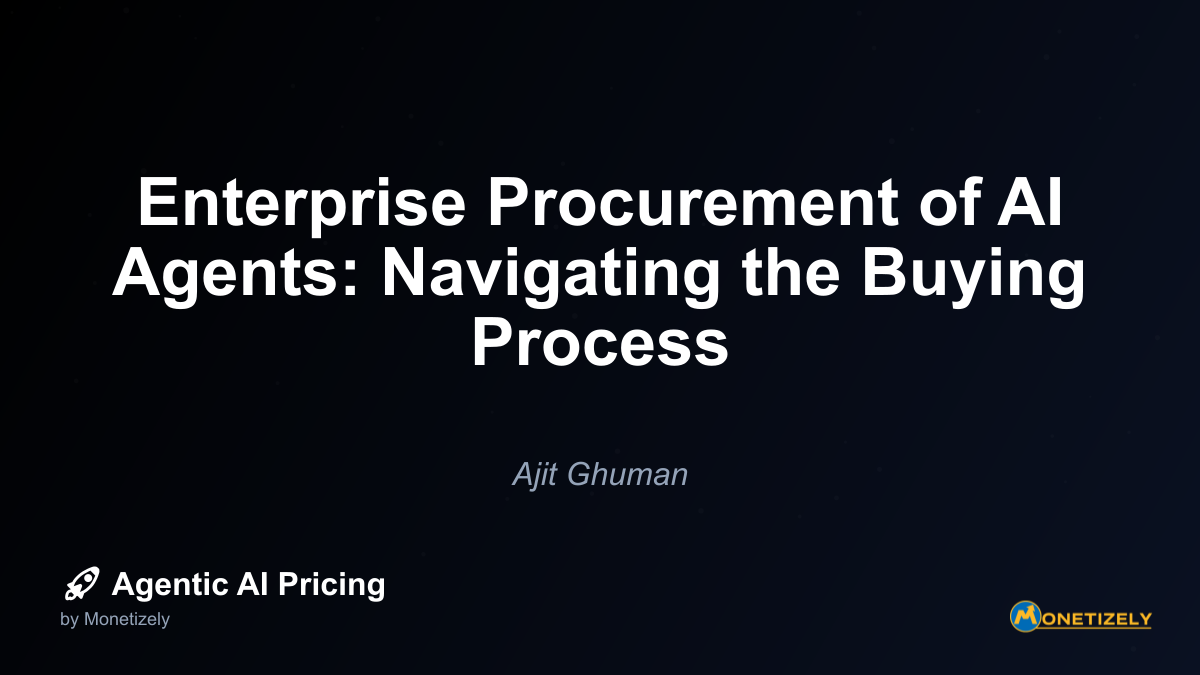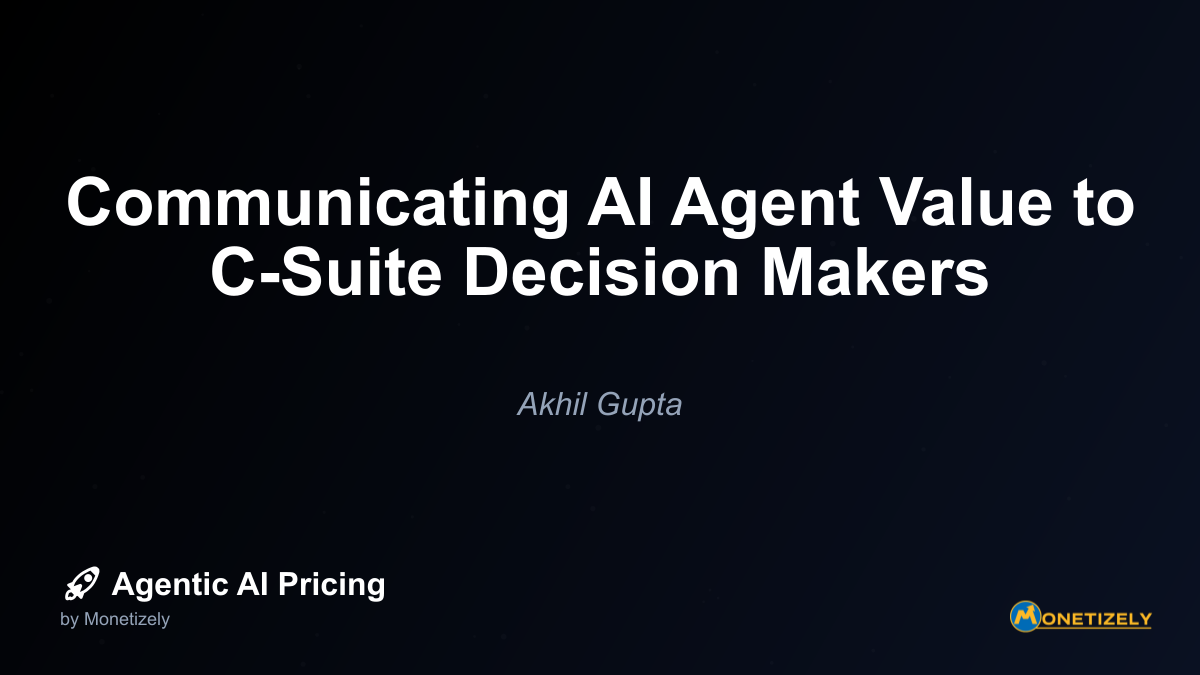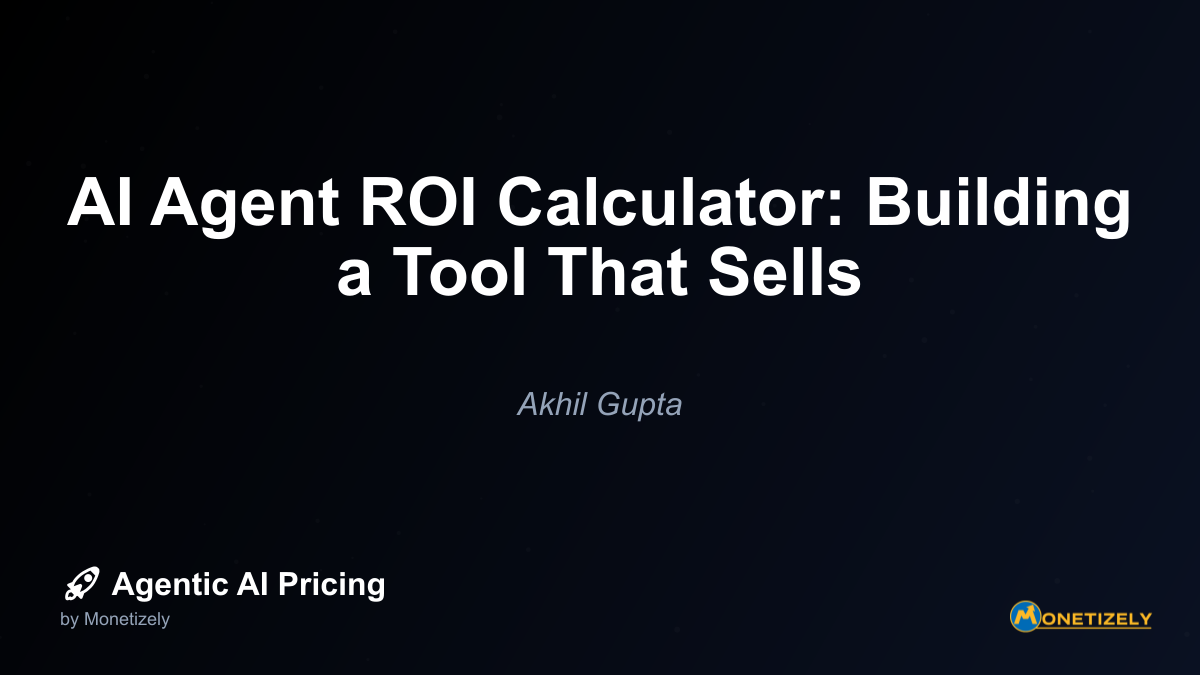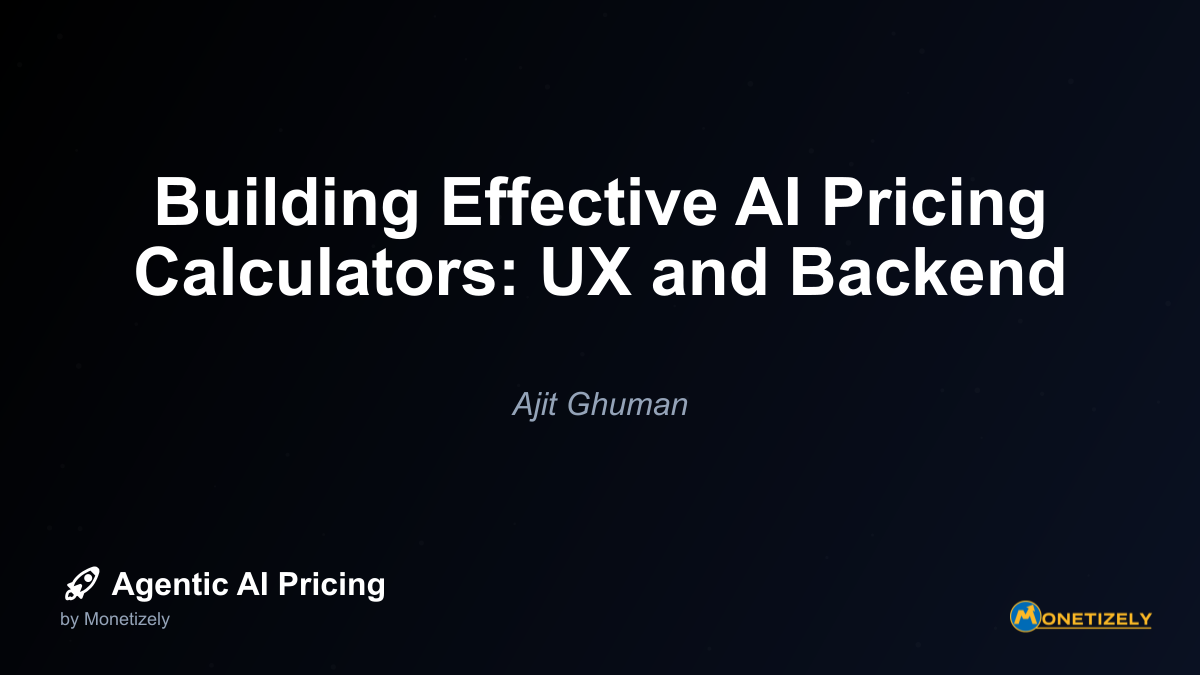· Ajit Ghuman · Communication & Messaging · 13 min read
Enterprise Procurement of AI Agents: Navigating the Buying Process
AI and SaaS Pricing Masterclass
Learn the art of strategic pricing directly from industry experts. Our comprehensive course provides frameworks and methodologies for optimizing your pricing strategy in the evolving AI landscape. Earn a professional certification that can be imported directly to your LinkedIn profile.

The enterprise procurement process for AI agents presents unique challenges and opportunities for vendors navigating complex buying journeys. Understanding the intricacies of how organizations evaluate, select, and implement AI solutions is critical for positioning your offering effectively and building lasting partnerships with enterprise clients.
Understanding the Enterprise AI Agent Procurement Landscape
Enterprise adoption of AI agents is accelerating rapidly, with the market projected to grow at a 28.1% CAGR, reaching USD 22.6 billion by 2033. This growth is driven by transformative applications across business functions, from automated procurement to intelligent customer service. However, the buying process for these solutions differs significantly from typical software purchases due to their strategic importance, technical complexity, and potential organizational impact.
Organizations are increasingly recognizing AI agents as strategic investments rather than tactical tools. According to recent research, 85% of procurement leaders express optimism about AI benefits, yet 61% have not fully integrated AI solutions, indicating significant untapped potential and implementation challenges. This gap presents both an opportunity and responsibility for vendors to guide prospects through a thoughtful, value-oriented buying journey.
The Seven Phases of Enterprise AI Agent Procurement
Enterprise procurement of AI agents typically follows a structured yet complex process spanning multiple phases, stakeholders, and evaluation criteria. Understanding this journey is essential for vendors seeking to position their solutions effectively.
1. Initial Discovery and Needs Assessment (3-6 weeks)
The procurement process begins with organizations identifying business needs and establishing strategic objectives for AI agent implementation. During this phase, enterprises focus on:
- Defining specific problem areas and use cases where AI agents could deliver value
- Establishing preliminary budget parameters and ROI expectations
- Aligning AI initiatives with broader organizational strategies
- Identifying key stakeholders and forming evaluation committees
Key stakeholders: C-suite executives (especially CIO/CTO/CPO), business unit leaders, procurement teams, and IT specialists all play critical roles during this initial phase.
Documentation requirements: Needs analysis reports, business case documentation, and preliminary budget estimates are typically developed.
Vendor strategy: At this stage, successful vendors focus on educational content and consultative conversations rather than aggressive selling. Providing thought leadership through case studies, ROI calculators, and industry benchmarks helps position you as a trusted advisor rather than simply a technology provider.
“The most successful AI agent vendors enter the conversation early, helping shape the customer’s understanding of what’s possible rather than simply responding to predefined requirements,” notes Sarah Chen, Principal Analyst at Forrester Research.
2. Vendor Identification and Preliminary Evaluation (4-8 weeks)
Once needs are established, organizations begin researching potential vendors and conducting initial capability assessments. This phase typically involves:
- Market research to identify vendors with relevant AI agent capabilities
- Initial capability screening against core requirements
- Preliminary discussions with vendors to assess fit
- Review of case studies, reference customers, and industry recognition
Key stakeholders: Procurement teams, technical evaluators, and end-user representatives lead this phase.
Documentation requirements: Vendor lists, evaluation scorecards, and preliminary capability assessments (including autonomous intelligence and multi-agent capabilities).
Vendor strategy: Clear differentiation is critical during this phase. Focus on communicating your unique approach to AI agent development, highlighting domain expertise, technology maturity, and support capabilities. Be prepared to provide high-level demonstrations tailored to the prospect’s industry and use cases.
According to McKinsey research, enterprises are particularly concerned with explainability, integration capabilities, and scalability when evaluating AI agents—more so than with traditional software purchases. Addressing these concerns proactively can significantly strengthen your position.
3. Request for Proposal (RFP) and Formal Evaluation (8-12 weeks)
For significant AI agent investments, organizations typically issue formal RFPs to shortlisted vendors. This structured process includes:
- Detailed technical, functional, and commercial requirements
- Specific use cases and performance expectations
- Security, compliance, and governance requirements
- Pricing and licensing model evaluations
Key stakeholders: Procurement leadership, AI/technical experts, legal/compliance teams, and finance departments are heavily involved.
Documentation requirements: RFP documents, evaluation frameworks, scoring matrices, and risk assessment reports are developed and maintained.
Vendor strategy: Respond comprehensively to all requirements, but don’t limit your response to just answering questions. Use the RFP as an opportunity to educate and differentiate by highlighting innovations in autonomous capabilities, providing clear partnership models, and being transparent about costs and limitations.
“The most effective RFP responses we see don’t just answer the questions—they reshape the customer’s thinking about what’s possible with AI agents,” explains Michael Rodriguez, VP of Enterprise AI Solutions at Accenture.
4. Proof of Concept and Pilot Testing (6-12 weeks)
Before making significant investments, enterprises typically require proof of concept implementations to validate AI agent performance in their specific environment. This critical phase includes:
- Defining clear success criteria and evaluation metrics
- Implementing the solution in a controlled environment
- Testing integration with existing systems and workflows
- Evaluating user acceptance and adoption potential
Key stakeholders: Procurement teams, IT/integration specialists, end-users, and vendor technical teams collaborate closely.
Documentation requirements: PoC plans, success criteria definitions, pilot reports, lessons learned, and risk logs are maintained throughout.
Vendor strategy: Provide robust support during the pilot, adapting quickly to feedback and challenges. Focus on delivering measurable outcomes aligned with the client’s KPIs rather than simply demonstrating technical capabilities. Use this phase to build relationships with key influencers and decision-makers.
Recent data from Gartner indicates that 72% of enterprise AI initiatives that fail to progress beyond the pilot stage do so because of insufficient focus on business outcomes rather than technical limitations. Successful vendors maintain relentless focus on value demonstration.
5. Final Vendor Selection and Contract Negotiation (4-8 weeks)
Following successful pilot implementations, organizations move to final vendor selection and contract negotiation. This phase focuses on:
- Comparing PoC results against established criteria
- Finalizing commercial terms and pricing structures
- Negotiating service level agreements and support parameters
- Addressing legal, compliance, and security requirements
Key stakeholders: Procurement, legal counsel, finance, and vendor senior management are the primary participants.
Documentation requirements: Contract drafts, negotiation records, SLA agreements, and compliance certifications are finalized.
Vendor strategy: Maintain flexibility in negotiations while protecting your core business model. Be transparent about pricing, especially for consumption-based or outcome-based models. Position contract discussions as the foundation for a long-term partnership rather than a transactional relationship.
“The negotiation phase is where many AI agent deals derail,” notes procurement expert David Simchi-Levi. “Successful vendors focus on value-based pricing discussions rather than feature-by-feature comparisons.”
6. Implementation, Training, and Change Management (12-24 weeks)
Once contracts are signed, the focus shifts to implementation, which for AI agents involves significant technical and organizational change management:
- System deployment and integration with existing infrastructure
- User training and adoption programs
- Governance framework implementation
- Data integration and quality assurance
Key stakeholders: IT teams, business users, change management specialists, and vendor implementation experts collaborate extensively.
Documentation requirements: Implementation plans, training materials, change management communications, and governance documentation are developed.
Vendor strategy: Provide comprehensive implementation support beyond technical deployment. Help clients develop change management strategies, training programs, and governance frameworks. Position AI agents as augmentation tools rather than replacement technologies to address potential resistance.
A 2024 MIT Sloan Management Review study found that enterprises with robust change management programs were 3.5 times more likely to achieve expected ROI from AI investments than those focusing solely on technical implementation.
7. Post-Implementation Evaluation and Optimization (Ongoing)
The final phase involves ongoing monitoring, optimization, and expansion of AI agent capabilities:
- Performance monitoring against established KPIs
- Continuous improvement and feature enhancement
- Expansion to additional use cases and departments
- Regular governance and compliance reviews
Key stakeholders: Procurement and operations teams, vendor support, business users, and IT support maintain involvement.
Documentation requirements: Performance reports, optimization plans, support logs, and compliance audits are maintained.
Vendor strategy: Establish regular business reviews focused on value realization rather than just technical performance. Proactively identify optimization opportunities and expansion use cases. Build relationships with executive sponsors to position for renewal and expansion.
Strategic Pricing Presentation for Enterprise AI Agents
Pricing presentation represents one of the most critical aspects of the enterprise AI agent sales process. How you structure, communicate, and negotiate your pricing model significantly impacts both conversion rates and long-term customer relationships.
Evolution of AI Agent Pricing Models
The AI agent pricing landscape has evolved significantly, moving away from traditional software licensing toward more flexible and value-aligned approaches:
Subscription Models: While still common, pure seat-based pricing is declining as it often fails to align with the value delivered by AI agents. According to a 2025 report, pure seat-based models dropped from 21% to 15% adoption among AI companies within a year.
Usage-Based Pricing: Charging based on AI resource consumption, API calls, or tasks handled has grown rapidly, particularly for horizontal AI platforms and infrastructure services. This model aligns costs directly with utilization and scales naturally with customer value.
Outcome-Based Pricing: Increasingly popular for vertical AI solutions, this model ties pricing to successful outcomes (e.g., resolving customer support tickets or sales conversions). Zendesk’s approach of charging only when AI successfully completes a case exemplifies this trend.
Hybrid Models: Combinations of seat, usage, and outcome pricing have seen the most significant growth, increasing from 27% to 41% adoption among AI companies in a single year. These models provide flexibility for diverse enterprise needs while maintaining predictability.
Enterprise Evaluation of Cost-Benefit
Enterprises evaluate AI agent investments through rigorous ROI analysis involving multiple stakeholders. Key metrics include:
- Direct cost savings: Reduction in manual labor or support workload
- Revenue uplift: 3-15% increases reported in some industries
- Productivity gains: 35% faster lead conversions and process improvements
- Operational efficiencies: Marketing cost reductions up to 37% through automation
Beyond quantitative metrics, strategic benefits such as agility, scale, and risk mitigation also influence investment decisions. According to Gartner and Deloitte, enterprises typically allocate 8-12% of IT budgets toward AI initiatives, indicating significant investment potential.
Pricing Communication Strategies
Effective pricing communication is essential for navigating complex enterprise buying processes. Best practices include:
Value-Based Narratives: Frame pricing discussions around business outcomes and ROI rather than features or technical capabilities. Quantify the value of time savings, error reduction, and process improvements.
Transparent Tiering: Create clear, logical pricing tiers aligned with customer segments and use cases. Each tier should deliver complete value while providing natural expansion paths.
Interactive Tools: Develop ROI calculators and pricing configurators that help prospects visualize the relationship between investment and returns. These tools facilitate internal selling and budget justification.
Competitive Positioning: Highlight value differentiators rather than engaging in feature-by-feature comparisons. Focus on total cost of ownership, implementation requirements, and time-to-value.
“The most successful enterprise AI vendors don’t sell technology—they sell business outcomes with clear, quantifiable value,” observes pricing strategist Madhavan Ramanujam, partner at Simon-Kucher & Partners.
Key Stakeholders in the Enterprise AI Agent Buying Journey
Enterprise procurement decisions involve multiple stakeholders with diverse priorities and concerns. Understanding these perspectives is critical for effective messaging and relationship building.
C-Suite and Executive Leadership
Priorities: Strategic alignment, competitive advantage, risk management, ROI Key concerns: Business impact, cost justification, organizational disruption Effective engagement: Focus on strategic value, competitive differentiation, and board-ready ROI metrics. Provide executive summaries and peer case studies from similar organizations.
IT Leadership and Technical Evaluators
Priorities: Integration capabilities, security, scalability, governance Key concerns: Technical debt, resource requirements, maintenance burden Effective engagement: Demonstrate robust security frameworks, integration flexibility, and scalability. Provide clear technical documentation and access to engineering resources for detailed evaluation.
Business Unit Leaders and End Users
Priorities: Usability, workflow improvement, time savings, problem-solving Key concerns: Learning curve, process disruption, job impact Effective engagement: Focus on intuitive interfaces, workflow integration, and tangible productivity improvements. Provide hands-on demonstrations and user testimonials from similar roles.
Procurement and Finance
Priorities: Cost optimization, contract terms, vendor stability, compliance Key concerns: Budget predictability, hidden costs, vendor lock-in Effective engagement: Offer transparent pricing with clear value metrics. Provide flexible commercial terms and emphasize long-term partnership approach.
Common Objections and Effective Responses
Enterprise AI agent sales processes frequently encounter specific objections that require thoughtful, evidence-based responses.
”AI agents will replace our employees.”
Effective response: Position AI agents as augmentation technologies that handle routine tasks, allowing employees to focus on higher-value activities. Share case studies showing how organizations have redeployed staff to more strategic roles rather than reducing headcount.
”We can’t justify the cost compared to our current solution.”
Effective response: Shift the conversation from cost to value by quantifying both direct savings (labor, error reduction) and strategic benefits (scalability, consistency, 24/7 operation). Develop a comprehensive ROI analysis incorporating all value dimensions.
”We’re concerned about data security and compliance.”
Effective response: Detail your security architecture, compliance certifications, and governance frameworks. Offer to engage with security teams for technical deep dives and provide documentation on data handling practices. Consider offering on-premises or private cloud deployment options for sensitive use cases.
”The technology is too new and unproven.”
Effective response: Share success stories from similar organizations, focusing on measurable outcomes. Offer phased implementation approaches that minimize risk while demonstrating value. Provide access to reference customers willing to share their experiences.
”Integration with our existing systems will be too complex.”
Effective response: Outline your integration architecture and API capabilities. Showcase successful integrations with similar technology stacks and offer integration workshops to address specific concerns. Consider offering professional services or implementation guarantees.
The Role of Pilots and Proofs of Concept
Pilots and proofs of concept play a critical role in enterprise AI agent procurement, serving as both risk mitigation mechanisms and powerful sales tools.
Designing Effective Pilots
Define clear success criteria: Establish specific, measurable outcomes aligned with business objectives. These might include efficiency gains, error reduction, user satisfaction, or other relevant metrics.
Limit scope appropriately: Focus on demonstrating core value propositions rather than implementing all features. Select representative use cases that showcase both immediate value and future potential.
Involve actual end users: Ensure the pilot includes people who will actually use the system rather than just technical evaluators. Their feedback on usability and workflow integration is invaluable.
Establish realistic timelines: Set clear expectations for implementation, testing, and evaluation periods. Most enterprise AI agent pilots require 6-12 weeks for meaningful results.
Plan for data challenges: Address data quality, integration, and governance issues early to avoid delays. Consider using synthetic or anonymized data for initial testing if necessary.
Leveraging Pilots for Sales Advancement
Successful pilots create powerful momentum toward larger implementations when managed strategically:
Document and quantify all outcomes: Capture both quantitative metrics and qualitative feedback. Develop case studies and ROI analyses based on actual results.
Identify expansion opportunities: Use pilot insights to map additional use cases and deployment opportunities across the organization. Create a phased roadmap for broader implementation.
Build internal champions: Identify and support users who experience significant benefits. Equip them with data and talking points to advocate internally.
Address concerns proactively: Use the pilot to identify and resolve potential obstacles to full deployment. Develop mitigation strategies for technical, process, or organizational challenges.
Align pilot results with procurement criteria: Connect pilot outcomes directly to the evaluation criteria established in the RFP or selection process. Make the case for moving forward based on demonstrated results.
“A well-executed pilot does more than prove technical feasibility—it builds organizational momentum and creates internal champions for your solution,” notes enterprise sales expert Mark Roberge, former CRO of HubSpot.
Post-Implementation Success and Expansion Strategies
The procurement journey doesn’t end with implementation. Successful vendors focus on ensuring adoption, demonstrating value, and positioning for expansion.
Ensuring Adoption and Value Realization
Establish clear success metrics: Define and track KPIs aligned with the original business case. Regular reporting on these metrics maintains executive visibility and support.
Implement robust onboarding: Develop comprehensive training programs tailored to different user roles. Consider certification programs for power users who can support others.
Create feedback mechanisms: Establish channels for users to report issues, suggest improvements, and share success stories. Actively respond to this feedback to demonstrate commitment.
Conduct regular business reviews: Schedule quarterly reviews focused on value realization rather than just technical performance. Use these sessions to identify optimization opportunities and expansion use cases.
Positioning for Expansion and Renewal
Map the expansion landscape: Identify additional departments, use cases, or geographies that could benefit from your solution. Develop business cases for each expansion opportunity.
Cultivate executive relationships: Maintain engagement with senior stakeholders beyond the initial implementation. Share industry insights and strategic perspectives to position yourself as a trusted advisor.
Leverage success stories: Document and share internal success stories across the organization. Equip champions with materials to advocate for expanded use.
Anticipate renewal discussions early: Begin positioning for renewal at least six months before contract end dates
Co-Founder & CEO
Ajit is the author of Price To Scale, a top book on SaaS Pricing and is the Founder of Monetizely. Ajit has led and worked in pricing and product marketing at firms like Twilio, Narvar and Medallia. His work has been featured in Forbes and VentureBeat. Ajit regularly consults with software companies from Seed stage to post-IPO on pricing strategy. Ajit is also a highly-rated co-instructor for 'The Art of SaaS Pricing and Monetization' on Maven.
Pricing Strategy Audit
Let our experts analyze your current pricing strategy and identify opportunities for improvement. Our data-driven assessment will help you unlock untapped revenue potential and optimize your AI pricing approach.




